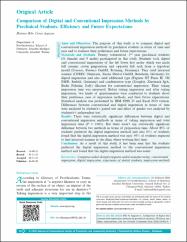| dc.contributor.author | Bilir, Halenur | |
| dc.contributor.author | Aygüzen, Ceren | |
| dc.date.accessioned | 2020-09-11T06:29:29Z | |
| dc.date.available | 2020-09-11T06:29:29Z | |
| dc.date.issued | 2020 | en_US |
| dc.identifier.citation | Bilir, H. ve Aygüzen, C. (2020). Comparison of digital and conventional impression methods by preclinical students: Efficiency and future expectations. Journal of International Society of Preventive and Community Dentistry, 10(4), 402-409. https://dx.doi.org/10.4103/jispcd.JISPCD_330_18 | en_US |
| dc.identifier.issn | 2231-0762 | |
| dc.identifier.issn | 2250-1002 | |
| dc.identifier.uri | https://dx.doi.org/10.4103/jispcd.JISPCD_330_18 | |
| dc.identifier.uri | https://hdl.handle.net/20.500.12511/5780 | |
| dc.description.abstract | Aims and Objectives: The purpose of this study is to compare digital and conventional impression methods by preclinical students in terms of time and ease and to evaluate their preferences and future expectations.Materials and Methods: Twenty volunteered, 2nd year preclinical students (11 females and 9 males) participated in this study. Students took digital and conventional impressions of the left lower first molar which was made full ceramic crown preparation and opposite full arch from a typodont model (Frasaco, Frasaco GmbH, Tettnang, Germany). They used intraoral scanner (CEREC Omnicam, Sirona Dental GmbH, Bensheim, Germany) for digital impression and also used additional type (Express XT Penta H, 3M ESPE, Seefeld, Germany) and condensation type (Zetaplus, Zhermack SpA, Badia Polesine, Italy) silicones for conventional impression. Their taking impression time was measured. Before taking impression and after taking impression, two kinds of questionnaires were conducted to students about their preference, ease of impression methods, and their future expectations. Statistical analysis was performed by IBM SPSS 23 and Excel 2010 version. Differences between conventional and digital impression in terms of time were analyzed by student's-t paired test and effect of gender was analyzed by students's-t independent test.Results: There were statistically significant differences between digital and conventional impression methods in terms of taking impression and total impression time (P < 0.001). But there wasn't any statistically significant difference between two methods in terms of preparation time. About 85% of students preferred the digital impression method and also 85% of students found that the digital impression method was easy. 95% of students expected to find intraoral scanner in the clinic where working first time.Conclusions: As a result of this study, it has been seen that the students preferred the digital impression method to the conventional impression method and found that the digital impression method was easier. | en_US |
| dc.language.iso | eng | en_US |
| dc.publisher | Wolters Kluwer Medknow Publications | en_US |
| dc.rights | info:eu-repo/semantics/openAccess | en_US |
| dc.rights | Attribution-NonCommercial-ShareAlike 4.0 International | * |
| dc.rights.uri | https://creativecommons.org/licenses/by-nc-sa/4.0/ | * |
| dc.subject | Computer-Aided Design/Computer-Aided Manufacturing | en_US |
| dc.subject | Conventional Impression | en_US |
| dc.subject | Digital Impression | en_US |
| dc.subject | Experience of Dental Students | en_US |
| dc.subject | Impression Methods | en_US |
| dc.title | Comparison of digital and conventional impression methods by preclinical students: Efficiency and future expectations | en_US |
| dc.type | article | en_US |
| dc.relation.ispartof | Journal of International Society of Preventive and Community Dentistry | en_US |
| dc.department | İstanbul Medipol Üniversitesi, Diş Hekimliği Fakültesi, Protetik Diş Tedavisi Ana Bilim Dalı | en_US |
| dc.authorid | 0000-0002-6576-6029 | en_US |
| dc.identifier.volume | 10 | en_US |
| dc.identifier.issue | 4 | en_US |
| dc.identifier.startpage | 402 | en_US |
| dc.identifier.endpage | 409 | en_US |
| dc.relation.publicationcategory | Makale - Uluslararası Hakemli Dergi - Kurum Öğretim Elemanı | en_US |
| dc.identifier.doi | 10.4103/jispcd.JISPCD_330_18 | en_US |
| dc.identifier.scopusquality | Q2 | en_US |




















